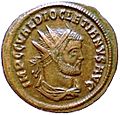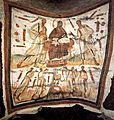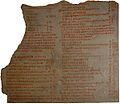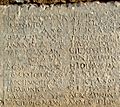Diocletian facts for kids
Quick facts for kids Diocletian |
|||||||||
|---|---|---|---|---|---|---|---|---|---|

Laureate head of Diocletian
|
|||||||||
| Roman emperor | |||||||||
| Reign | 20 November 284 – 1 April 286 | ||||||||
| Predecessor | Carinus (contested until July 285) | ||||||||
| Reign | 1 April 286 – 1 May 305 (in the east, with Maximian in the West) | ||||||||
| Successor | Galerius and Constantius Chlorus | ||||||||
| Born | Diocles 22 December 243–245 Salona (Solin, Croatia) |
||||||||
| Died | 3 December 311 Aspalathos (Split, Croatia) |
||||||||
| Burial | Diocletian's Palace | ||||||||
| Spouse | Prisca | ||||||||
| Issue | Valeria | ||||||||
|
|||||||||
| Religion | Roman polytheism | ||||||||
Diocletian (born Gaius Aurelius Valerius Diocletianus, around 245 AD – 312 AD) was a powerful Roman emperor. He ruled the Roman Empire from November 20, 284, to May 1, 305. He was born in Dalmatia, which is part of modern-day Croatia, to a family that was not rich.
Diocletian is famous for ending a difficult time in Roman history called the Crisis of the Third Century. This was a period (from 235 to 284 AD) when the Roman Empire faced many problems, including civil wars, invasions, and economic troubles. Diocletian worked hard to bring Rome back to its former strength and glory by making big changes in important areas like religion, the economy, and the military.
Diocletian's Religious Beliefs
Diocletian strongly supported the traditional polytheistic religion of the Romans, which meant believing in many gods. He wanted everyone in the empire to follow these ancient Roman customs. He was very strict about this and took strong actions against those who did not follow the traditional Roman gods, including Christians.
Economic Changes
The Roman Empire was having money problems, especially with inflation, which means money was losing its value very quickly. Diocletian tried to fix this. He noticed that a lot of gold was leaving the western part of the empire and going to the east.
To help the economy, he made new rules about coins. He said that coins should only be made of gold or silver, stopping the practice of using cheaper metals like lead. He also improved the tax system to make it fairer and more efficient. However, some of his economic plans did not work as well as he hoped.
Military Reforms
Diocletian made important changes to the Roman army. Before him, the army mainly used a "garrison defense," where large groups of soldiers stayed in one place. Diocletian changed this by placing smaller groups of soldiers in outposts along the empire's borders.
He recruited local soldiers from areas near the Rhine and Danube rivers. These soldiers often lived with their families in villages and also farmed. They used signal towers to light fires and warn other outposts if German tribes tried to invade. These border soldiers received regular pay from Rome for their service. Diocletian also made it possible for soldiers to advance in the army based on their years of loyal service and brave actions in battle.
A New Way to Rule: The Tetrarchy
Diocletian created a new system of government called the tetrarchy. This word means "rule by four." In this system, the vast Roman Empire was divided into four parts, and each part was ruled by a different co-emperor.
Diocletian took control of the eastern part of the empire. He chose a trusted fellow officer, Maximian Augustus, to rule the western part. These two were the senior emperors, called Augustus. Later, two junior co-emperors were added: Galerius and Constantius Chlorus. These junior emperors were called Caesar.
In 305 AD, Diocletian and Maximian both decided to step down from their roles. This was a very unusual thing for Roman emperors to do. After they retired, the two junior emperors, Galerius and Constantius Chlorus, became the new senior emperors (Augustus). They then chose their own junior emperors: Severus II in the west and Maximinus in the east. This showed how the Tetrarchy system was designed to continue itself.
Leaders from Illyria
Many of these emperors, including Diocletian, came from the Roman province of Illyria. This region, which is now part of the Balkans, was a very important place for recruiting soldiers for the Roman army. Since the time of Emperor Domitian (81–96 AD), more than half of the Roman army was stationed in the Danube regions.
Over time, Romanized Illyrians became very important officers in the army. Eventually, these Illyrian military leaders gained control of the Roman government itself.
Imperial Capitals
Under the Tetrarchy, the four emperors did not live in Rome. Instead, they set up their main headquarters in other cities that were closer to the empire's borders. These cities were chosen because they were better for defending the empire against enemies like the Persians in the east and various Germanic tribes along the Rhine and Danube rivers.
These four cities became known as the 'Tetrarchic capitals'. Even though Rome was no longer the main place where the emperors lived and worked, it was still considered the most important city of the entire empire. Rome had its own special governor, called the Prefect of the City. The four Tetrarchic capitals were:
- Nicomedia (modern-day Izmit in Turkey) was the capital for Diocletian, the senior emperor in the east. It was important for defending against invasions from the Balkans and Persia.
- Sirmium (modern-day Sremska Mitrovica in Serbia) was the capital for Galerius, the junior emperor in the east. It was located near the Danube border.
- Mediolanum (modern-day Milan in Italy) was the capital for Maximian, the senior emperor in the west. It was close to the Alps.
- Augusta Treverorum (modern-day Trier in Germany) was the capital for Constantius Chlorus, the junior emperor in the west. It was near the important Rhine border.
Other important cities included Aquileia, a port on the Adriatic coast, and Eboracum (modern-day York in northern England). These cities were significant centers for Maximian and Constantius, respectively.
The four emperors did not have strict, separate areas of control. Each emperor had a general area where they focused their efforts, mainly for leading the army in times of war. The emperors often traveled with their armies, leaving most of the daily administration to their officials.
Retirement and Death
Diocletian's changes greatly improved the Roman government and helped the empire's economy and military. His reforms helped the empire stay strong for another hundred years, even though it had been close to falling apart when he was young.
Diocletian became ill and decided to leave his position as emperor on May 1, 305 AD. He was the first Roman emperor to ever willingly step down from power. He spent his retirement living in a grand palace on the Dalmatian coast, where he enjoyed tending to his vegetable gardens. His palace eventually grew into the modern city of Split.
After Diocletian retired, Maximian tried to return to power, but Diocletian ordered him to step down permanently. Eventually, Maximian was forced to take his own life, and the Tetrarchy system began to fall apart. Diocletian felt great despair about this and died in 311 AD.
Images for kids
-
Carausius, rebel emperor of Roman Britain. Most of the evidence for Carausius's reign comes from his coinage, which was of generally fine quality.
-
Triumphal arch of the Tetrarchy, Sbeitla, Tunisia
-
A Trajanic temple on the island of Philae, the newly established border between the Nobatae and Blemmyes and Roman Egypt
-
Detail of Galerius attacking Narseh on the Arch of Galerius at Thessaloniki, Greece, the city where Galerius carried out most of his administrative actions
-
A fragment of the Edict on Maximum Prices (301), on display in Berlin
-
The monolithic granite column shaft of the Diocletianic honorific column in the Serapeum of Alexandria called "Pompey's Pillar" is 20.75 metres (68.1 ft) tall. Built 298–303.
See also
 In Spanish: Diocleciano para niños
In Spanish: Diocleciano para niños
















